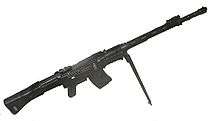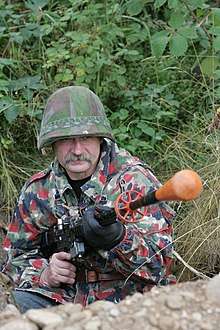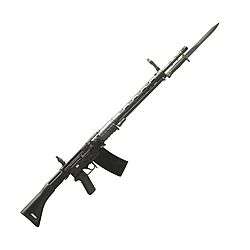SIG SG 510
The SIG SG 510 or Sturmgewehr 57 is a selective fire battle rifle designed by Schweizerische Industrie Gesellschaft (now SAN Swiss Arms) of Switzerland. It uses a roller-delayed blowback system similar to the H&K G3 and CETME rifles. The SIG SG 510-1 entered service in the Swiss Army with the designation F. ass. 57 (French/Italian, for Fusil d'Assault 57/Fucile d' Assalto 57) or Stgw. 57 (German for Sturmgewehr 57).
| SIG SG 510 | |
|---|---|
Sturmgewehr 57 (Stgw 57/SG 510-1) | |
| Type | Battle rifle |
| Place of origin | Switzerland |
| Service history | |
| In service | 1957–1990 |
| Used by | See Users |
| Wars | 1973 Chilean coup d'état |
| Production history | |
| Designer | Rudolf Amsler |
| Designed | 1950s |
| Manufacturer | Schweizerische Industrie Gesellschaft (SIG) |
| Produced | 1957–1983 |
| Variants | SG 510-1, SG 510-2, SG 510-3, SG 510-4 |
| Specifications | |
| Mass | 5.70 kg (12.57 lb) (Stgw 57) 4.37 kg (9.63 lb) (SG 510-4) |
| Length | 1,100 mm (43.3 in) (Stgw 57) 1,015 mm (40.0 in) (SG 510-4) |
| Barrel length | 609 mm (24.0 in) (Stgw 57) 505 mm (19.9 in) (SG 510-4) |
| Cartridge | 7.5×55mm GP 11 (Stgw 57) 7.62×51mm NATO (SIG 510-4) |
| Action | Roller-delayed blowback |
| Rate of fire | 450–600 rounds/min |
| Muzzle velocity | 750 m/s (2,460 ft/s) |
| Effective firing range | 640 m (700 yd) iron sights 800 m (875 yd) Kern 4×24 optical sight |
| Feed system | 6-, 20-, or 24-round detachable box magazine |
| Sights | Front post, rear aperture |
The Sturmgewehr 57/SIG SG 510-1 was adopted for Swiss military service in 1957 and was, in 1990, replaced by the lighter SIG SG 550, although some reservists used it for several years longer.
Design details
The SG 510 is derived from the AM55 developed during the late 1950s. During its development Rudolf Amsler was the principal designer at Schweizerische Industrie Gesellschaft. It is a selective fire rifle that employs a roller-delayed blowback operating system. As with all roller-delayed designs, the roller recesses in the receiver will eventually wear down, and begin to increase the cartridge headspace. Many roller-delayed blowback weapons accept this as the functional service life of the rifle, but the SIG 510 has interchangeable locking recesses, so they can be replaced when worn. The Stgw. 57 was used by the Swiss Army as a personal universal weapon. In Swiss service it replaced the K31 rifle, the Suomi M-31 submachine gun and the Lmg 25 magazine fed light machine gun.
Features

The weapon is mainly made of pressed sheet-metal components to ease mass production and incorporates the "straight-line" recoil configuration. This layout, placed both the center of gravity and the position of the shoulder stock nearly in line with the longitudinal axis of the bore, a feature increasing controllability during burst or automatic fire. The SG 510 has a distinctive T-shaped bolt handle similar to the earlier K31 rifle.
For recoil reduction the fixed butt-stock was designed with durability in mind and is fitted with a recoil buffer to cope with the recoil produced by heavy rifle grenades in use by the Swiss military. The SG 510-1/Stgw. 57 sports a large carrying handle at its balance point that can be used during quick position changes or on the march. The butt-stock and hand guard of the SG 510-1/Stgw 57 are molded out of solid rubber for comfort and the front hand guard is ribbed to provide a better grip.
Barrel
The SG 510-1/Stgw 57 barrel is relatively thick and rifled along 520 mm (20.5 in) of its 609 mm (24.0 in) length and has a 270 mm (1 in 10.6 in) 4 groove rifling.[1] At the end of the barrel an integral 26 mm (1.0 in) long muzzle brake/flash hider is fitted that reduces recoil by about 25%. The 609 mm (24.0 in) total length barrel and muzzle device also functions as rifle grenade spigot.
The barrel is surrounded by a perforated tubular barrel jacket with two spring detents for a sliding, underfolding integrated bipod—one near the muzzle to reduce shot dispersion during automatic fire, and another nearer the receiver and balance point offering more flexibility in the rifle role. The Stgw. 57 bipod legs are marked for use as an inclinometer for aiming rifle grenades at various ranges with and without an additional booster-charged rifle grenade. For such indirect rifle grenade fire, the Stgw. 57 was set on the ground and a weighted string attached near the muzzle was used as a plumb-line to set the correct firing angle reference mark on the bipod leg. Swiss army knives were often used as a makeshift plumb bob at the end of the string.
Trigger mechanism
The trigger mechanism has a three-position fire selector switch that is also the manual safety toggle that secures the weapon from accidentally discharging. The user selects the operating mode with a large side lever on the left side of the receiver that can be rotated to select S (safe), E (semi-automatic fire) or M (full-automatic fire).
On the right hand side of the rifle, there is a foldaway 'winter' trigger which enables the operator to use the rifle with arctic mittens. It is also used for rifle grenade firing to avoid recoil induced hand injuries.
Sights

The SG 510-1/Stgw. 57 has a straight-line stock design, and an elevated iron sights line with a relatively long 635 mm (25.0 in) sight radius. Both the front and rear sights can be folded down when not in use. The rear peep sight of the Stgw. 57 can be adjusted from 100 to 640 m (109 to 700 yd). From 100–200 m (109–219 yd) the sight adjusts in 50 m (55 yd) increments. From 200–300 m (219–328 yd) in 33 m (36 yd) increments, and from 300–640 m (328–700 yd) in 20 m (21.9 yd) increments.[2]
According to the Swiss Army the 50% windage and elevation dispersion shot at 300 m from a machine rest averages 6 cm (2.4 in).[2] The employed circular error probable method cannot be converted and is not comparable to US military methods for determining rifle accuracy. When the R50 results are doubled the hit probability increases to 93.7%. For anti-personnel use, the SG 510-1/Stgw. 57 typical maximum range for consistent accuracy is 800 m (875 yd).
For designated marksman use, the SG 510 can be equipped with a quick-detachable Kern 4×24 telescopic sight. The sight weighs 730 g (26 oz) and includes a variety of features, such as mounting components, a Bullet Drop Compensation (BDC) elevation adjustment knob for ranges from 100 to 800 m, an illuminated reticle that enables target acquisition in low-light conditions and a diopter eyesight correction adjustment. Included with the sight is a lens hood for mounting on the ocular that reduces image quality-impairing stray light and a gray filter for glare reduction.[3] A night vision sight with an infra red light can also be mounted. The Chilean version can fit a German-made Supra 4×24 telescopic sight.
Accessories

The Swiss Army Stgw 57 is fed from curved detachable box magazines, made from aluminum and containing 24 rounds weighing 250 g (8.8 oz) empty and 900 g (31.7 oz) fully loaded. Special silver coloured magazines that can contain 6 Gewehr- Treibpatronen 44 grenade-launching cartridges for use with rifle grenades weigh 230 g (8.1 oz) empty and 325 g (11.5 oz) fully loaded. The PE 57 had 5- and 10-round magazines available as well. Magazines with 20-round capacities for the 510-4 in 7.62 NATO and 30-round originally for the LMG 25 may operate in the Stgw. 57 as well. Other accessories include the sling, the bayonet, and a special small-capacity magazine for grenade-launching cartridges.
Rifle grenades can be launched without adding a special provision. Grenade-launching cartridges enable the SG 510-1/Stgw. 57 to fire Gewehrgranaten 58 rifle grenades which weigh 1.16 to 1.18 kg (2.56 to 2.60 lb) depending on the warhead type. The rifle grenade 58 achieves a muzzle velocity of 35 m/s (115 ft/s) and a maximum range of 125 m (137 yd) without the help of a booster charge or 70 m/s (230 ft/s) and a maximum range of 400 m (437 yd) with the help of a booster charge. The rifle grenade 58 may be fitted with the following warheads:
- Hollow charge for heavy armor (direct fired only). Modern hollow charge rifle grenades can penetrate 300 to 500 mm (12 to 20 in) of "best quality" armour plating.
- Anti-personnel fragmentation with impact detonator (direct or indirect fired).
- Smoke canister for reducing visibility (direct or indirect fired).
- Practice (inert orange rubber)
Civilian use
Upon completion of their military service, members of the Swiss armed forces could obtain ownership of their personal Stgw. 57 rifle by paying an administrative fee. These "civilianised" Stgw 57 rifles were converted to a semiautomatic only configuration. Dedicated factory-built, semiautomatic only rifles for private purchase were available and designated PE 57, PE means Privat Einzelfeuer (Private Singlefire). These civilian PE 57 rifles incorporate subtle design changes to avoid some cross-compatibility with army rifle parts. As of 2007, around 40 percent of discharged soldiers choose to retain their weapon (nowadays the SIG SG 550), and the going rate for civilianised SG 510 rifles on the private weapons market is reported to vary between 300 and 500 Swiss francs.[4]
In Switzerland the SG 510 is also used for target shooting matches. For this the standard iron sights can be replaced by target shooting diopter and globe sight sighting lines. When the sighting line radius is kept at its original length Swiss sport shooters refer to a such modified rifle as Stgw 57/02. When the sighting line radius is lengthened by mounting the globe sight nearer to the muzzle it is referred to as Stgw 57/03.
SG 510-4 7.62×51mm NATO variant

The SG 510-4 chambered in 7.62×51mm NATO with a 305 mm (1 in 12 in) twist rate barrel was adopted by Chile and Bolivia. The SIG SG 510 is officially classed as an automatic rifle but served as a designated marksman weapon (in Chile with Supra 4×24 scope).
Variants
- 510-1: Standard Swiss service rifle.
- 510-2: Lightened variant of the standard rifle.[5]
- 510-3: 7.62×39mm variant with shorter barrel. This was produced in small numbers as a prototype and offered to the Finnish Army. They did not want it, hence, this model of the rifle was never mass-produced.[5]
- 510-4: 7.62×51mm NATO variant used by Bolivia and Chile. This version uses a shorter barrel and a buttstock made from wood rather than rubber. Overall length is much less than the Stgw 57 with a subsequently lower weight. The buttstock is angled downward rather than straight inline with the receiver.
- AMT: semi-automatic only variant of the 510-4 imported into the United States in relatively small numbers. It was available in .308 (7.62×51). "AMT" stood for "American Match Target". It was equipped with fine wooden furniture and a rounded upper handguard.
- 510-5: .30-06 Springfield (7.62×63mm) experimental rifle made for testing by the Mexican Government.
- 510-6: 7.5×55mm Swiss test batch of rifles based on the 510-4 in the Swiss military caliber intended to replace the heavier Stgw 57. The rifles were only built for testing and didn't win the contract as a replacement. The contract went to the SIG 550 rifle which became known as the Stgw 90.
- SIG PE 57: (Privat Einzelfeuer) semi-automatic only civilian version available in 7.5×55mm GP 11 Swiss. This variant is not the same as privatised former Swiss Army service rifles. It was specifically built as a semi auto only rifle along the lines of the Stgw 57 with which it is frequently confused. While over 700,000 of the Stgw 57s were built for military use less than 5000 PE57s were made.
Users
Gallery
 Stgw 57 with iron sights, bayonet and folded bipod. On display at Morges castle museum.
Stgw 57 with iron sights, bayonet and folded bipod. On display at Morges castle museum. Stgw 57(/03) modified for sport shooting with a diopter and globe sight sighting line.
Stgw 57(/03) modified for sport shooting with a diopter and globe sight sighting line. Receiver of a Stgw 57, seen from the right.
Receiver of a Stgw 57, seen from the right. Receiver of a Stgw 57(/03) modified for sport shooting, seen from the left.
Receiver of a Stgw 57(/03) modified for sport shooting, seen from the left.- Stgw 57 dismantled.
- Stgw 57, bolt, recoil spring.
- Stgw 57 trigger housing with winter trigger extended.
- Stgw 57 bayonet and frog.
- Stgw 57 cleaning kit pouch.
- Left to right; boosted and unboosted orange training and a Gw HPz G 58 armour piercing rifle grenades
- Gw HPz G 58 armour piercing hollow charge rifle grenade poster
- Gw St G 58 fragmentation rifle grenade poster
- Gw Nb G 58 smoke rifle grenade poster
References
- "PE-57 manual" (PDF).
- Swiss Army Sturmgewehr 57 Manual (German)
- Kern 4x24 telescopic sight
- Stefan von Below (19 October 2007). "Ein Gewehr kostet 60 Franken und fünf Kreuze". Der Bund. p. 21.
- Stgw. 57 / Sig 510 assault rifle (Switzerland) Archived 2005-11-20 at the Wayback Machine. Modern Firearms. Accessed 15 August 2009.
- Jones, Richard D. Jane's Infantry Weapons 2009/2010. Jane's Information Group; 35 edition (January 27, 2009). ISBN 978-0-7106-2869-5.
- Giletta, Jacques (2005). Les Gardes Personnelles des Princes de Monaco (1st ed.). Taurus Editions. ISBN 2 912976-04-9.
- Abbot, Peter (February 2014). Modern African Wars: The Congo 1960–2002. Oxford: Osprey Publishing. p. 24. ISBN 978-1782000761.CS1 maint: ref=harv (link)
External links
| Wikimedia Commons has media related to: |